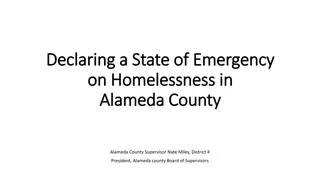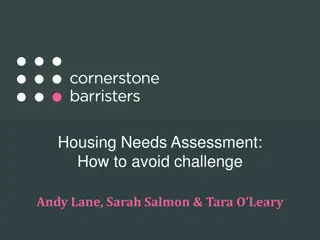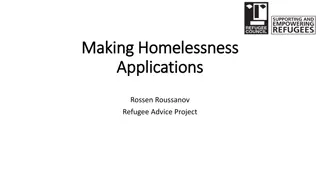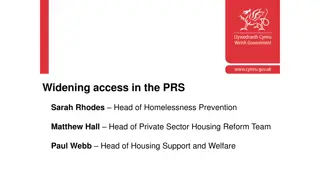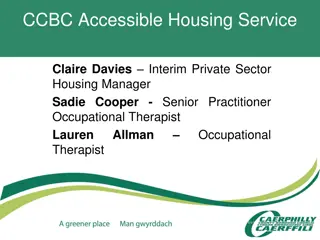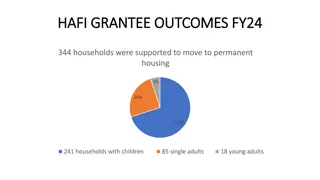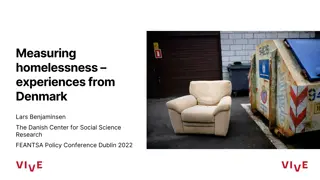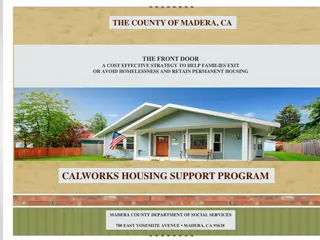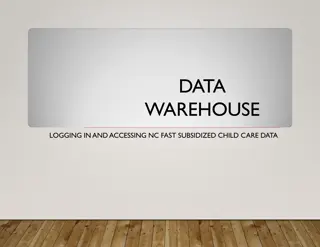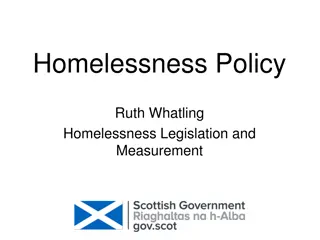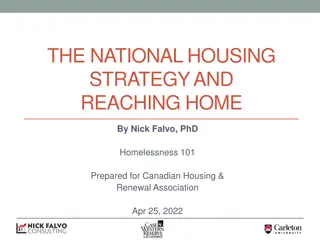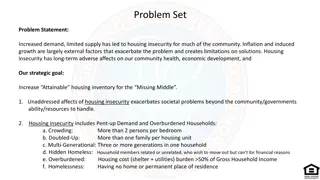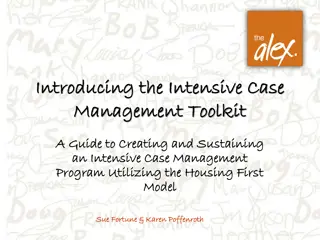Can Subsidized Housing Help Address Homelessness in New England?
This article by Robert Clifford and Osborne Jackson explores the effectiveness of subsidized housing in addressing homelessness in New England. The authors analyze data and policy implications from the New England Public Policy Center and the Federal Reserve Bank of Boston regarding the impact of subsidized housing on homelessness in the region.
Download Presentation

Please find below an Image/Link to download the presentation.
The content on the website is provided AS IS for your information and personal use only. It may not be sold, licensed, or shared on other websites without obtaining consent from the author. Download presentation by click this link. If you encounter any issues during the download, it is possible that the publisher has removed the file from their server.
E N D
Presentation Transcript
Can Subsidized Housing Help Address Homelessness in New England? Robert Clifford and Osborne Jackson November 18, 2015 New England Public Policy Center Federal Reserve Bank of Boston
Overview of findings 2 The number of sheltered homeless families in Massachusetts and Vermont is on the rise, driving an increase in measured homelessness in New England. LIHTC developer incentives lead to more projects in New England and larger projects outside the region. The majority of evidence suggests increases in subsidized housing are likely to reduce local homelessness, particularly in New England.
Definition and Measurement 3 Current federal definition, updated in 2009: Literal homeless: Unsheltered and sheltered (e.g., emergency shelter and transitional housing) Vulnerable or at-risk populations: Losing their primary nighttime residence, including those living in a motel/hotel or doubled-up situations. Defined under other federal statutes: Includes unaccompanied youth or families with children and youth. Domestic violence: People who are fleeing or attempting to flee domestic violence. Measurement: HUD Point-in-Time Estimates (PIT) A one night snapshot of the literal homeless conducted in January.
Rising homelessness in New England is driven by higher rates of sheltered families 4 Homelessness Rates by Family and Sheltered Status, 2007 2014 Homeless per 10,000 Residents 14 NE - Sheltered Families 12 NE - Sheltered Individuals 10 US - Sheltered Individuals 8 US - Sheltered Families US - Unsheltered Individuals 6 NE - Unsheltered Individuals 4 US - Unsheltered Families 2 NE - Unsheltered Families 0 2007 2008 2009 2010 2011 2012 2013 2014 Source: U.S. Census Bureau population estimates and U.S. Department of Housing and Urban Development homeless Point-in-Time estimates.
Why is family homelessness on the rise in New England? 5 Three potential hypotheses: 1. National market forces interacting with area- specific shelter policies. 2. Area-specific market forces. 3. Measurement differences among homeless subpopulations.
Area-Specific Shelter Policies 6 Massachusetts is the only state with a right to shelter. Stems from a law passed in 1983 that has been revised multiple times in the past 30 years. Currently, the state provides targeted emergency shelter assistance, subject to appropriations, for needy families with children and pregnant women. Vermont General Assistance and Cold Weather Exemption General Assistance: Provides emergency housing for up to 28 days for vulnerable populations such as the elderly, disabled, and families with children or pregnant women. Cold Weather Exemption: Allows homeless families and individuals access to shelter on severe winter weather days. Policies are not new or unique, as New York City and Washington, DC have similar policies in place.
Rates of homeless sheltered families are rising in targeted shelter policy areas 7 Rates of Sheltered Homeless Persons in Families, 2007 2014 Homeless per 10,000 Residents 70 Washington, DC New York, NY Massachusetts Vermont United States NE less MA & VT 60 50 40 30 20 10 0 2007 2008 2009 2010 2011 2012 2013 2014 Source: U.S. Census Bureau population estimates and U.S. Department of Housing and Urban Development homeless Point-in-Time estimates.
Relationship between homelessness and housing burdens is weak in New England 8
Measurement error: the unsheltered homeless population is difficult to count 9 The PIT count is conducted in January because it is easier to count people in shelters than on the street or in other places not meant for human habitation... (HUD 2008). Researchers (e.g., Corinth 2015) have also noted the difficulty in counting the street population due to: Individuals avoiding the counts Difficulty covering large areas Differing count methodologies Laws criminalizing homelessness Undercounted or missing unsheltered homeless populations can lead to misinterpretations of rising levels of sheltered homeless (e.g., compositional shifts).
A role for subsidized housing? 10 Legislation passed by the U.S. Congress in 2009 amending the definition of homelessness included this statement: a lack of affordable housing and limited scale of housing assistance programs are the primary causes of homelessness. The extent to which such assistance can help to alleviate homelessness is dependent on: The demand for low-income housing by the homeless. The supply of such housing through federal and state programs.
The homeless are composed of many different subpopulations 11 Share of Homeless Population by Category, 2014 Sheltered Families Mentally Ill Substance Abuse Chronic Domestic Violence Veteran New England United States Unaccompanied Youth 0% 25% 50% 75% 100% Source: U.S. Department of Housing and Urban Development, 2014 Point-in-Time estimates. Note: Categories are not mutually exclusive, so shares do not sum to 100 percent.
LIHTC is the largest and fastest growing project-based subsidized rental program 12 Share of Federally Subsidized Rental Units by Program, 2012 100% 3.9% 5.6% Other HUD Programs 5.1% 3.2% 7.8% 10.5% USDA Rural Rental Assistance and Housing Loans 80% 17.0% 15.7% LMSA Section 8/RAPSUP 60% 12.7% Public Housing 18.3% Project-Based Section 8 24.3% 40% Housing Choice Vouchers (HCV) 28.6% 10.5% LIHTC/HCV 20% 6.5% 18.7% Low-Income Housing Tax Credit (LIHTC) 11.6% 0% United States New England Source: U.S. Department of Housing and Urban Development, A Picture of Subsidized Housing, US HUD LIHTC database, and U.S. Department of Agriculture, Rural Development Programs.
The Low-Income Housing Tax Credit 13 Created under Tax Reform Act of 1986. Provides tax incentive to develop rental units targeted at low-income (LI) households. Developers obtain credits through competitive process. Dollar-for-dollar reduction in tax liabilities over 10 years. Rent limits on LI units ( 18% of area median income). Projects in Qualified Census Tracts (QCTs) receive thirty percent more credits. LIHTC activity may jump once QCT eligibility threshold crossed. Creates a quasi-random experiment in housing placements. Examine impact of LIHTC development on local homelessness.
Importance of a quasi-random experiment 14 Allows location of development sites to be unrelated to neighborhood traits like poverty or unemployment. Without random housing placement, sites may be selected due to local factors also affecting homelessness. Difficult to isolate the impact of subsidized housing on homelessness without a (quasi-)random experiment.
Example: comparing neighborhoods 15 Tract A: 5 projects, 20 homeless, 10% poverty. Tract B: 15 projects, 70 homeless, 25% poverty. True effect of subsidized housing on homelessness: Assume: 1 project 10 fewer homeless. If Tract A had 6 projects, there would be 10 homeless individuals. If Tract B had 16 projects, there would be 60 homeless individuals. Estimated effect of subsidized housing on homelessness: Comparing tracts A and B: 1 project 5 more homeless. Problem: project placement related to homelessness (not random). Link may be direct, indirect via poverty, or via some other observed or unobserved factor(s).
Homelessness rates vary across areas of New England 16 New England County 2000 Homelessness Rates, per 10,000 Residents Source: 2000 U.S. Census. Note: To excludes the value listed afterwards, while through includes the value listed afterwards. Number of counties in each category listed in parentheses.
QCT eligibility induces developers to provide more subsidized housing 17 Impact of QCT Eligibility on LIHTC Development QCT Eligibility Threshold Source: U.S. Department of Housing and Urban Development LIHTC data and QCT eligibility data and authors calculations. Note: A tract is QCT-eligible when at least 50 percent of households have incomes below 60 percent of AMI. In the figure, tracts are categorized by percentage of eligible households and are grouped into 2.5 percentage point bins.
Developer response to QCT eligibility differs by region 18 Within New England: More LIHTC projects: 0.25 more projects (157% increase in average tract), mostly through rehabilitation (81%). Outside of New England: Larger LIHTC projects: 6.2 more units (68% increase in average tract), mostly through new construction (65%). Use quasi-random local housing development to estimate impact on neighborhood homelessness. Projects (NE) and units (non-NE). Link via unit-project ratio in average tract (57 units per project).
Accounting for mobility, subsidized housing likely reduces local homelessness 19 Impact of LIHTC on Neighborhood Homelessness Estimated under Various Scenarios Source: U.S. Department of Housing and Urban Development LIHTC data and QCT eligibility data, U.S. Census data, and authors calculations.
Conclusions 20 Large increases in the number of sheltered homeless families in Massachusetts and Vermont are driving up measured homelessness in New England. LIHTC developer incentives lead to more rehabilitation projects in New England and larger new construction projects outside the region. Bulk of evidence suggests subsidized housing is likely effective at reducing neighborhood homelessness, particularly in New England.
Caveats and discussion 21 Impact of subsidized housing in moderately-poor tracts. Outcomes may differ in very rich or very poor neighborhoods. LIHTC-specific program features may play a role. Share of projects targeted to the homeless. Results for a supply-side housing program may differ from a demand-side program. Rent and income limits tied to area (supply) vs. person (demand). Further work also needed on alternative hypotheses (e.g., area-specific shelter policies) to understand relative importance of local housing market forces.
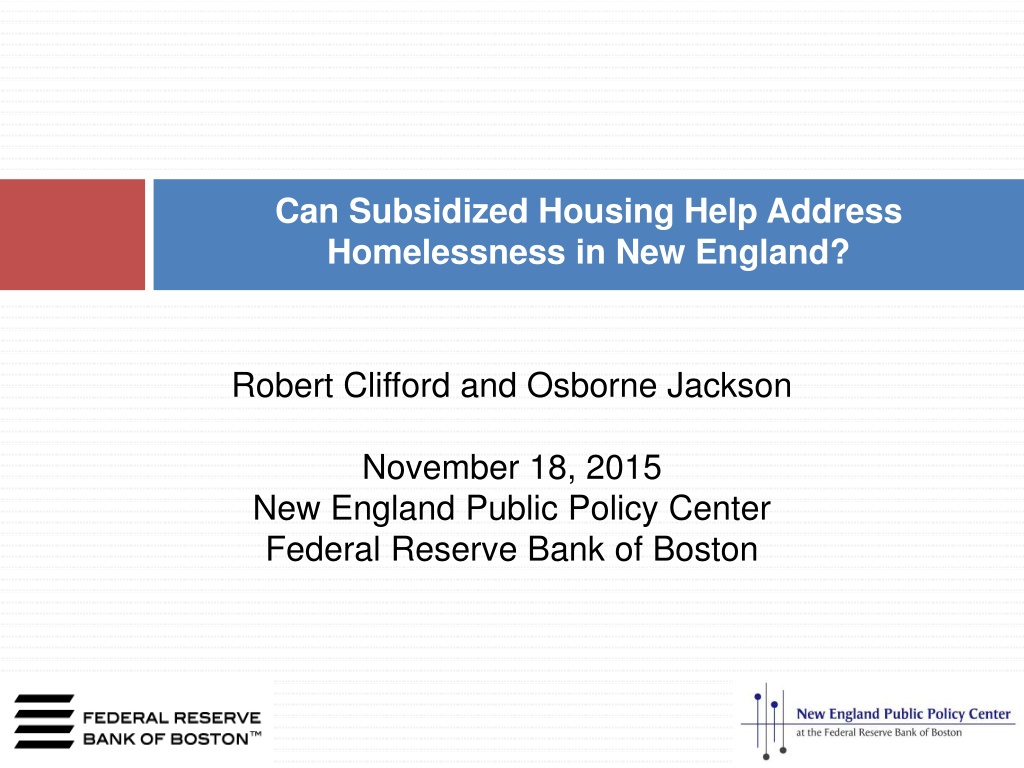
 undefined
undefined









